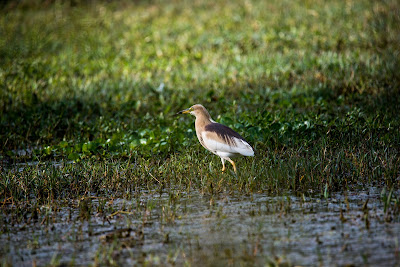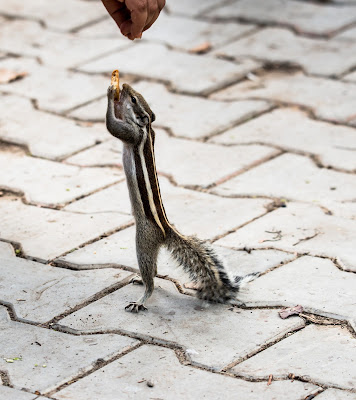The month of March - Holi and Good Friday holiday in sequence. A loooong week end. We set out for Bharatpur Bird Sanctuary, in Rajasthan. Bharatapur is four an half hour journey from Gurgaon. There are three routes to follow.
Best time to visit is from December to February. March is almost end of the season. Well, Holi and Good Friday did not occur in February.
Alternate name of the sanctuary is Keoladev National Park. It is in east Rajasthan, about 2 km south east of Bharatpur. It is about 50 km from Agra.
The road was good enough to drive so to say. Start early morning and one can hit Bharatpur in less than five hours easily, even with one break for breakfast.
There are many decent looking hotels near to Sanctuary, that can be booked online in advance. However enough care needs to be taken to ensure that you get what you paid for.
The sanctuary is open from 0630 to 1830 hrs. Entry fee is Rs.75 per head per entry. Parking place is available at a fee of Rs.50/- No fee for normal and DSLR camera, though the notice board says fee is applicable to professional movie cameras. (few thousands, I did not note it down).
Foreign nationals to pay a little more.
You can walk around the place following the trail or take a cycle on rent or a cycle rickshaw on rent. Two people can occupy a rickshaw.
Interestingly the cycle rickshaw driver can double up as your guide too. There are certified Guides available at Rs.150/ hour. Cycle Rickshaw costs Rs.100/- hour. Two persons can occupy one rickshaw.
We chose the cycle rickshaw and he as our guide. These cycle “guides” are well aware of the route, spots and the name of the birds surprisingly quite well.
I went inside the park four times in two days, every time with a new cyclist. Fourth time I walked alone.
Best time to visit the park is early morning or evening. I have clicked several pictures of many beautiful birds.
I still feel quite strongly that I need to hone my photographic skill. I am not where I thought I was.
I still put up some of my picture and try to provide some relevant info. As I said earlier also, I am not the expert like the great Salim Ali and do not pretend to be one. I surf through the net and grab the info and place it here.
Pictures are of-course mine.
There are many decent looking hotels near to Sanctuary, that can be booked online in advance. However enough care needs to be taken to ensure that you get what you paid for.
The sanctuary is open from 0630 to 1830 hrs. Entry fee is Rs.75 per head per entry. Parking place is available at a fee of Rs.50/- No fee for normal and DSLR camera, though the notice board says fee is applicable to professional movie cameras. (few thousands, I did not note it down).
Foreign nationals to pay a little more.
You can walk around the place following the trail or take a cycle on rent or a cycle rickshaw on rent. Two people can occupy a rickshaw.
Interestingly the cycle rickshaw driver can double up as your guide too. There are certified Guides available at Rs.150/ hour. Cycle Rickshaw costs Rs.100/- hour. Two persons can occupy one rickshaw.
We chose the cycle rickshaw and he as our guide. These cycle “guides” are well aware of the route, spots and the name of the birds surprisingly quite well.
I went inside the park four times in two days, every time with a new cyclist. Fourth time I walked alone.
Best time to visit the park is early morning or evening. I have clicked several pictures of many beautiful birds.
I still feel quite strongly that I need to hone my photographic skill. I am not where I thought I was.
I still put up some of my picture and try to provide some relevant info. As I said earlier also, I am not the expert like the great Salim Ali and do not pretend to be one. I surf through the net and grab the info and place it here.
Pictures are of-course mine.
Sarus Crane
The Sarus Cranes above - a pair with its baby crane. A pair in another picture above. They walk with a grace, beautiful to watch. These are tallest birds can grow as tall as 1.8 mtr. It is believed that once they pair, they will live together for ever.
Grey Heron
Look at the Grey heron in some “Yoga” pose ! Grey Heron is another non migratory, beautiful bird. It wades through shallow water, marshy land and hunts the fish. Here in the picture, it must be drying its wings. It stood in this posture for hours. Below is the picture of a mother and a baby heron.
Indian Pond Heron
The Indian Pond Heron, is an elegant bird with white grey plumage, a brown stripe on its back and an yellow beak with a black tip. It wades through shallow water slowly and hunts the fish.
Bar Headed Goose
Bar headed Goose - the name comes from the fact that they have the bars on their head. They are migratory known to fly past Himalayan ranges at an altitude of about 800 mtr. Amazing birds. These are said be from Mangolia.
Gargeney Ducks
The Garganey is a small dabbling duck. It breeds in much of Europe and western Asia, but is strictly migratory, with the entire population moving to southern Africa, India and Australasia in winter, where large flocks can occur. It is a beautiful duck with stripes and spots.
Brown Headed Barbet
Brown headed Barbet is resident bird found in Indian continent widespread, quite common.
Spot Billed Duck
Spot billed duck with its ducklings. It was probably teaching the flock to swim and dabble in the wetland. It was continuously moving all over back and forth. The spot-billed duck sometimes referred to as the spot-bill, is a dabbling duck which breeds in tropical and eastern Asia.
Ruddy Shelduck
A distinctively colored duck with rusty plumage which looks different from almost all other ducks. Also known as Brahminy duck in India.
Pied KingFisher
It is a water kingfisher. Its black and white plumage, crest and the habit of hovering over clear lakes and rivers before diving for fish makes it distinctive. It can hover like a chopper. Look at its head and beak, quite big compared to its body.
Green Pigeon
Simple - green Pigeons are green.
Grey Francolin also called as Partridge
The grey francolin (formerly also called the grey partridge, is a species of francolin found in the plains and drier parts of South Asia. They are found in open cultivated lands as well as scrub forest. In Hindi the local name of teetar. It is mostly found on the ground, running around, rarely flying.
Painted Stork
Flock of Painted Stork. It is really big and beautiful bird. In the above middle a juvenile standing in a tricky posture. In the just above picture the mother is teaching the babies to dabble around.
Lesser Whistled Duck
The lesser whistling duck, also known as Indian whistling duck or lesser whistling teal, is a species of whistling duck that breeds in the Indian Subcontinent and Southeast Asia. They are nocturnal feeders and during the day may be found in flocks around lakes and wet paddy fields.
Common Coucal
Striped Squirrel
The tiny cute squirrels are galore here. They are so friendly and familiar with travelers. They come closer and receive the eatable directly. They even jump like dog to grab the eatable piece from your hand. Very nice cute ones.
Northern Shoveler
The northern shoveler, sometimes known simply as the shoveler, is a common and widespread duck. It breeds in northern areas of Europe and Asia and across most of North America, wintering in southern Europe, Africa, the Indian subcontinent, Southeast Asia, and Central, and northern South America
Brahminy Starling
It is a resident breeder in Nepal and India, a winter visitor to Sri Lanka and a summer visitor in parts of the western Himalayas and northeastern Himalayas. They are spotted in plans of Pakistan as well. This passerine is typically found in dry forest, scrub jungle and cultivation and is often found close to human habitations, especially favorite areas with waterlogged or marshy lands
Flock of Darter or Snake birds
Spotted Deer with a calf
 |




























